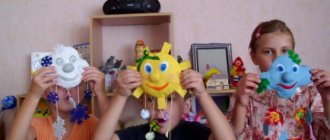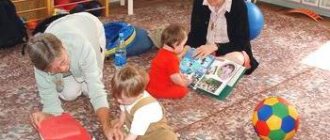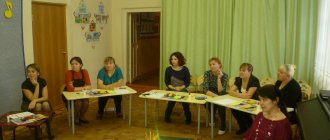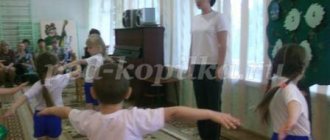Finger gymnastics class in the preparatory group of a preschool educational institution
Children 6–7 years old have fairly well developed fine motor skills and coordination of movements. They are more often involved in dynamic exercises, with an increase in the tempo of execution. Warm-up for hands (exercises imitating the movements of animals and plants) is carried out before drawing or writing. Children are attentive and active, able to learn a new game in a group lesson. The children should sit relative to the teacher so that everyone can see the movements shown:
- The teacher and children sit at a large table (the desks can be moved);
- the guys sit on chairs in a row, the teacher sits opposite (on a chair or on the floor);
- The children and the teacher sit in a circle on the carpet.
Video: finger game on the theme “Dishes” in the preparatory group
The video shows how to perform finger gymnastics in a music room. The children are seated on chairs, and the teacher sits on his knees in front of them. Children can clearly see the teacher’s movements, and the position he adopts is favorable to them; they feel the game situation, and not the seriousness of the learning process.
When learning a new exercise, the teacher demonstrates the movements by example.
If the children have difficulties during a familiar game, the teacher prompts not by direct demonstration, but by verbal instructions: “Quickly move our fingers,” “Now you need to knock on your knees with your fists,” etc.
By the last year of kindergarten, children know a lot of static finger exercises. In the preparatory group, games are combined into a complex: the teacher names the figures at a given pace, the children fold their fingers on command:
- “Ring”: fold the index finger and thumb into a ring.
- “Second ring”: fold the ring with the second hand.
- “Chain”: connect two “rings”, interlock links from fingers.
- “Chair”: the fist of the second hand is adjacent to the vertically placed palm of one hand, etc.
Children 6–7 years old are attentive and dexterous, quickly learning a new game
The teacher should not get carried away with learning a large number of games with children. The main way for preschoolers to learn information is repetition. Pupils repeat games learned in the middle and high groups. Once mastered, the game should transition into an active gaming experience. To ensure that familiar finger gymnastics exercises do not lose their attractiveness for children, the training must be “enriched”:
- invite children from the younger group or parents to a lesson and arrange a master class on finger games (children love not only to learn new things, but also to share knowledge);
- conduct an unusual activity: a trip to a fairy tale or a quest, during which the children will remember finger games;
- Together with the students, prepare attributes for games: masks, hats, decorations.
Handmade attributes encourage preschoolers to play
Table: card index of finger exercises
| Theme of finger gymnastics | Examples of games and exercises |
| "Family" |
|
| "Friendship" |
|
| "Motherland" |
|
| "Products" |
|
| "Home"/"Kindergarten" |
|
| "Animals, birds, insects" |
|
| "Nature, seasons" |
|
| "Fairy tales" |
|
| "Fun Games" |
|
Gallery: examples of cards with finger games
The game “Rain” can be played at the beginning of gymnastics
The game "Friendship" can be used as a means of reconciling quarreling children
The game “Favorite Tales” can be played during a speech development class or thematic leisure time
It is recommended to learn the folklore game “In the damp forest” with song accompaniment
The game “Autumn” is learned at the beginning of the school year
Traditionally, the game “Mushrooms” is learned in September and included in the Autumn Festival program
In December, the game “Winter” is learned, preferably with musical accompaniment
The game "Clothes" is suitable for repetition with acceleration
Games about furniture are held in classes on speech development (respectively, on the topic “Furniture”)
The game "Furniture" is a complex of finger movements
A game based on the poem “One day a housewife came from the market” is studied while learning the lexical topic “Vegetables”
In this unconventional game, movements are performed using a su-jok ball.
Games about household appliances are unexpected and arouse increased interest among children
During the dynamic game “Porridge Machine” the fingers are actively working
The game "Dishes" is a great way to warm up your hands.
A continuation of this game could be a thematic performance in a finger theater
Patriotic themed games are held at matinees on February 23 and May 9
Finger games-songs
A teacher who uses ICT (information and computer technologies) in classes should prepare a folder with video materials on finger games. A large number of song games are freely available on pedagogical portals and Internet channels. They are cartoons of the content of songs, audio recordings and schematic instructions for performing movements with the hands. There are song games with only musical accompaniment; they are recommended for preschoolers to play when they have learned the lyrics and are ready to sing on their own. There are also educational videos with finger games based on English songs for children.
Video: finger song game “Chickens”
Video: finger game-song “Autumn Leaves” (backing track)
Video: finger game-song “Little Katya” (“Helpers”)
Temporary lesson plan for finger gymnastics
In the preparatory group, the duration of a finger games lesson can be up to 10 minutes. It is expected that during this time period the children will learn a new game, remember a familiar one, and play shadow or finger theater on their own for a few minutes.
If the lesson does not include time for free activity, its optimal duration is 5 minutes. These 5–10 minutes are “pure” finger play time. The integrated lesson lasts in accordance with the standards for children 6–7 years old. For example, a music lesson in a preparatory group lasts 30 minutes, of which 5 can be allocated to finger games and songs.
Gymnastics for fingers evokes positive emotions and allows children to take a break from intense intellectual activity.
Table: approximate time plan for finger gymnastics “Pets”
| Lesson stage | Contents, duration |
| Greeting, organizational moment | 1 minute |
| First task | A chain of static exercises (“Goat”, “Cat”, “Rooster”, etc.) - 1 minute |
| Second task | Finger game “The cat bites hard” (2–3 repetitions) – 1–1.5 minutes |
| Third task | Massage of fingers and palms - 1.5–2 minutes |
| Total duration | 4.5–5.5 minutes |
Table: approximate time plan for the lesson “Journey to the land of finger games”
| Lesson stage | Contents, duration |
| Organizing time | 1 minute |
| First task | Finger-speech game “Boat” - 1 minute |
| Second task | Game “Let’s rustle with pencils” – 1 minute |
| Third task | Search for objects in the touch pool - 1-2 minutes |
| Fourth task | Improvisation in finger theater - 3–5 minutes |
| Total duration | 7–10 minutes |
Free time to play in the finger theater is an opportunity for preschoolers to relax, socialize and have fun
Regular finger exercises (games and self-massage) instill in children the useful habit of relaxing, training fine motor skills and remembering poems and songs. Finger games promote the development of attention and memory, speech and imagination - cognitive abilities necessary for a first-grader.
Recommendations for performing exercises
- Prepare your child for this type of training. It is necessary to discuss its contents in advance and practice several gestures.
- An adult authorized to do the training should prepare a text in advance.
- Before starting work, you need to warm up your palms by stroking.
- The presenter shows how interesting this type of entertainment is.
- It is imperative to complete the assigned tasks at a slow pace.
- The child must perform the technique correctly; he needs help.
- It is important that all exercises performed bring only joy to the child.
- Each task is performed for 2-3 minutes, alternating 3 days.
- Daily workouts.
- Easy tasks are used to develop interest.
- Gradually replace 2-3 exercises, depending on the degree of difficulty.
- Be sure to use color images and musical accompaniment.
For children 6-7 years old, training accompanied by songs and rhymes is suitable. For development, a good task would be a shadow theater. If parents decide to exercise their fingers on their own, they must be in a good mood. Children remember everything, and interest in subsequent lessons will depend on the first lesson.
Important! The speed of execution should not be fast, but there should be no pauses. It is necessary to increase the speed gradually.
Drawing lessons in the second junior group
Types of exercises
All games are divided into three groups.
- Exercises that affect the hands. What we get from this type of activity:
- The skill of relaxing and tensing muscles develops;
- Imitative ability develops;
- Developing the skill of keeping fingers in one position for a while;
- Switch from a certain subject to another.
- Statistical work for fingers. These exercises help to carry out early experience in a certain direction, at a high level.
- Dynamic work for fingers. What will happen if you follow these exercises:
- Movement coordination will develop;
- Oppose thumbs to others.
Unconventional finger games
“Non-traditional” finger games are games with different objects. That is, you can take any object in the child’s field of vision. For example, it will be a pencil.
On a note! It is advisable that both parents and children take a pencil in their hands and begin to rub it palm against palm, while the most important thing is to say either poems or nursery rhymes between their fingers.
Here you can use a special “hedgehog ball”, sand and many other items.
How to do gymnastics correctly
This may include the following training:
- Massage of hands and fingers with walnuts;
- Special massage brushes;
- Balloons. Various materials can be used for these types of entertainment:
- natural,
- household,
- junk.
Non-traditional games are a universal, didactic educational activity. The main goal of this entertainment is that the nerve endings in the fingers affect the minds of children. That is, the baby’s brain activity begins to work well.
Game form of classes on traffic rules with preschoolers according to the Federal State Educational Standard
What are the effects of non-traditional forms of finger gymnastics:
- Speech development;
- Development of concentration;
- Preparing children for writing;
- Development of coordination.
For greater benefit of these games, you need to use rhymes, nursery rhymes, songs, and counting rhymes. As a result, the baby will receive a varied sensory experience.
Attention! When engaging in this type of play with your baby, a lot depends on the parents. Parents need to create a cozy and pleasant environment. This type of entertainment builds good relationships between children and adults.






